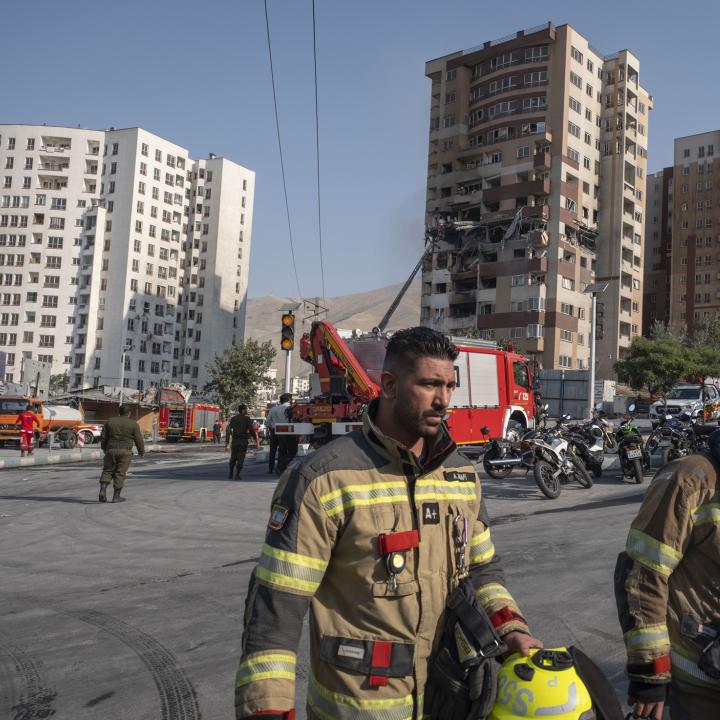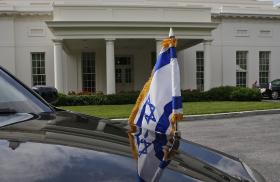
- Policy Analysis
- PolicyWatch 4054
From Diplomacy to Military Force: The Future of Iran’s Nuclear Program

U.S. and Israeli experts assess the quickly evolving situation as the IDF continues striking targets across the country, Tehran retaliates with missile salvos, and the international community mulls how best to contain the crisis.
On June 16, The Washington Institute held a virtual Policy Forum with Michael Eisenstadt, Zohar Palti, Dennis Ross, and Dana Stroul. Eisenstadt is the Institute’s Kahn Senior Fellow, director of its Military and Security Studies Program, and author of its recent paper “Attacking Iran’s Nuclear Program: The Complex Calculus of Preventive Action.” Palti is the Institute’s Viterbi International Fellow and former head of the Israeli Defense Ministry’s Policy and Political-Military Bureau. Ross is the Institute’s Davidson Distinguished Fellow and a former senior official in the Reagan, Bush, Clinton, and Obama administrations. Stroul, the Institute’s director of research and Kassen Senior Fellow, formerly served as deputy assistant defense secretary for the Middle East in the Biden administration. The following is a rapporteur’s summary of their remarks.
Michael Eisenstadt
Israel’s Operation Rising Lion stemmed from growing concerns that Iran had resumed nuclear weapons research and development work in the past year or so. In the wake of the October 7, 2023, attack on Israel, leaders concluded that they could no longer tolerate an implacably hostile Iran with a growing stockpile of fissile material, which could provide the basis for a large nuclear weapons arsenal to arm its rapidly growing missile stocks.
Accordingly, Israel’s main goal is to inflict maximum damage on the Iranian nuclear and missile programs and the military-industrial infrastructure supporting them. Attacks on the country’s leadership, air defenses, and other targets are intended to support this goal or serve other objectives. Similarly, fomenting regime change may be an aspirational goal but is not yet a formal goal.
Although the conflict may further weaken Iran, deterring a nuclear breakout remains complex. Historical precedent from Iraq and elsewhere shows that airpower alone cannot dismantle a large, dispersed program (never mind a hardened and buried one like Iran’s). Israel is well aware of this—National Security Advisor Tzachi Hanegbi recently acknowledged that only negotiations have dismantled nuclear programs in the past (see South Africa and Libya). Thus, one Israeli objective may be to impose sufficient costs on Iran to induce a return to negotiations so that talks can resume under more favorable terms, as Tehran will be in even greater need of post-conflict sanctions relief to preserve regime stability and carry out reconstruction.
Israel also needs to avoid actions that could trigger escalation and constrain its freedom of action in the future. In the event that a new nuclear deal proves unattainable and Iran tries to rebuild the program, such constraints could prevent the launch of Israeli follow-on strikes as part of a “mowing the grass” policy.
So how does this end? Three distinct scenarios are possible: a tenuous ceasefire, likely followed by renewed Iranian efforts to rebuild its nuclear and missile programs, with Israel taking steps to disrupt these efforts; renewed nuclear negotiations as a result of Iranian military exhaustion, fear of domestic unrest, and/or fear of U.S. military intervention; or regime collapse (though this seems unlikely).
Some have also questioned whether Israel should eliminate Supreme Leader Ali Khamenei. Given his generally cautious posture, however, a preferable scenario may be a weakened, chastened version of the Supreme Leader who provides a perpetual reminder of his regime’s folly, as opposed to a new, unpredictable, perhaps more reckless successor.
Zohar Palti
The October 7 attack was a seismic event in the Middle East, and its aftershocks continue to reshape the region, from Gaza to Lebanon to Syria and now Iran. Israel’s sweeping operation follows a slow-burning standoff that ignited in April 2024, when Iran crossed a major threshold by directly attacking Israel. That strike shattered a psychological barrier, intensified Israeli fears, and ultimately led Jerusalem to conclude that it had to take action against Iran’s nuclear progress. Now Tehran is firing ballistic missiles at Tel Aviv and Haifa, and while most have been intercepted, some have caused tragic casualties.
The objective of Israel’s campaign is twofold: to prevent Iran from acquiring a nuclear weapon, and to permanently alter the regime’s behavior in the region. With the country’s air defenses largely neutralized, the Israeli Air Force enjoys near-unimpeded access to Iranian skies. So far, targets have included Islamic Revolutionary Guard Corps command centers, missile systems, nuclear facilities, and state broadcasting facilities, among other assets.
These operations will severely degrade if not dismantle most of Iran’s nuclear infrastructure and capabilities. Either Tehran accepts a ceasefire in the next couple days, or Israel will put all military options on the table, including energy infrastructure, political leadership, and military bases. Targeting political leaders is not inevitable—Israel currently has a good opportunity to finish its main objectives quickly without resorting to such action. But if things escalate, casualties rise, or Tehran refuses to back down from its present position, Israel is prepared to conduct strikes on oil and natural gas sites, regime focal points in the provinces, and senior leadership.
Iran has not experienced aerial bombardment since the end of the Iran-Iraq War in 1988. Hence, the current campaign presumably came as a profound shock to the regime and its public, especially after Israel established total air superiority over the entire country within two days.
As the campaign proceeds, it is uncertain if the United States will back a strike on Iran’s most fortified nuclear site, the Fordow enrichment plant. But if Washington provides that support, the Israeli government may be more willing and able to meet the Trump administration’s calls to end the war in Gaza and finalize a hostage deal.
Dennis Ross
Connecting diplomacy to the rapidly evolving military confrontation is essential. The dramatic shift in the regional balance of power presents a rare diplomatic opening, and seizing it will require a clear sense of U.S. objectives, an understanding of what is achievable, and smart use of the tools at the Trump administration’s disposal.
Iran has already begun signaling a willingness to negotiate, quietly reaching out to Arab states even as the fighting proceeds. Foreign Minister Abbas Araghchi recently noted that Iran is ready to halt hostilities as long as Israel does the same. He and other officials are well aware that the regime is increasingly vulnerable—its regional proxy network has remained largely silent so far, and domestic pressures are mounting. At its core, the regime prioritizes survival and will take steps to avoid direct conflict with the United States.
While some parties are exploring a ceasefire, important caveats remain. Israel is intent on resetting the rules of regional deterrence, so it may have little appetite for an immediate truce. Washington must therefore engage in close, candid dialogue with Jerusalem to understand its strategic goals. At minimum, any ceasefire must align with Israeli objectives and compel Iran to abandon its nuclear ambitions, halt ballistic missile production, and stop efforts to rebuild its proxy network. If Tehran fails to meet these conditions, Washington and its partners should not ease sanctions.
On the military front, President Trump has sent mixed messages on the administration’s willingness to participate directly in striking Fordow, but that does not mean coercive threats should be removed from the table. Maintaining heavy pressure on the regime is vital.
If Trump does decide to intervene militarily, Gaza will almost certainly factor into his decisionmaking. Delivering a decisive win against Iran would boost Israeli Prime Minister Binyamin Netanyahu politically, which could in turn give him more room for maneuver on ending the Gaza war.
Dana Stroul
For the past five U.S. administrations, presidents from both parties concluded that negotiations are preferable to military force in meeting the challenge of Iran’s nuclear program. Concerns about striking the program generally fell into three categories: (1) that a military strike could delay and disrupt—but not eliminate—Iran’s ability to develop a nuclear weapon; (2) that Tehran would retaliate harshly, including with its ballistic missile arsenal and international terrorist networks; and (3) that a strike could convince Iran’s leaders to rush for a nuclear weapon.
In the post-October 7 strategic environment, however, Israel’s leaders could no longer tolerate the risk of aggressive Iranian nuclear steps. For example, just days before Israel began Operation Rising Lion, the director-general of the International Atomic Energy Agency reported that there is no peaceful explanation for Iran’s latest nuclear activity. If Israeli leaders had confidence that the U.S. nuclear talks would block all of Tehran’s pathways to a nuclear weapon, it is fair to conclude that they would not have felt compelled to strike on the eve of further negotiations in Oman. Moreover, experiences over the past year have lowered Israel’s fear barrier and instilled confidence that it could confront Iran’s network of terrorist and nonstate actors, defend against ballistic missile attacks, and effectively strike inside the Islamic Republic.
Going forward, U.S. policy should focus on how best to achieve two objectives: (1) keep Iran from developing a nuclear weapon (a longstanding American interest), and (2) prevent the current conflict from expanding, including through direct Iranian or proxy attacks against U.S. or allied interests in the Middle East. A particularly urgent priority is protecting U.S. personnel in the region. Soon after the conflict broke out, the U.S. embassy branch office in Tel Aviv was damaged by an Iranian ballistic missile attack, a suicide drone was downed as it targeted the U.S. consulate in Erbil, Iraq, and U.S. service members at al-Asad Air Base had to take cover from incoming attacks.
It is time to assess whether U.S. red lines have already been crossed. It is also important to acknowledge that although the conflict has seen limited collateral damage or spillover so far, one misstep could lead to a mass-casualty event.
Washington has several tools available to shape the trajectory of the fighting and protect its interests. For instance, senior officials could visit Israel to consult on short- and long-term goals. The administration could also convene its network of allies and partners for coordinated diplomatic efforts to make clear that Iran can no longer have a pathway to a nuclear weapon. At the same time, the United States can signal resolve by increasing its regional military posture (as it did after October 7), reaffirming its commitment to resupply Israel’s munitions and air defense, and providing logistical assistance and other support for Israel’s operations.
All of these options would support Israel’s defense; a U.S. decision to pursue offensive operations is also an option. Whatever the case, each of these efforts should be considered not in isolation, but as part of an overall strategy to block all of Iran’s paths to a weapon and prevent the current conflict from expanding.
This summary was prepared by Audrey Kost. The Policy Forum series is made possible through the generosity of the Florence and Robert Kaufman Family.





